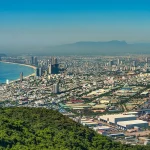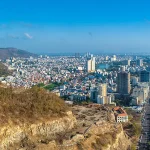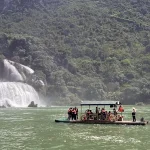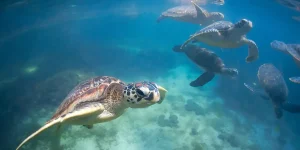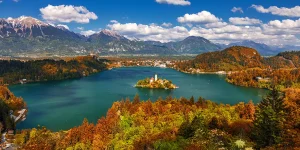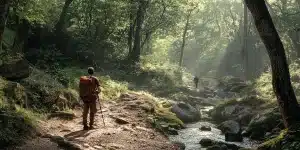Get ready for something wild. This is your one-stop source for the boldest, most unforgettable adventure activities on the planet. We’re talking about the kind of experiences that leave your pulse racing and your story list stacked—from jungle flights to Arctic dives and everything in between.
Whether you’re planning your next thrill-filled getaway or building out your someday bucket list, Guides and Storiesbrings you a handpicked collection of raw, real-deal adventures. Some are intense. Some are unexpected. All are designed to shake up the way you explore the world.
This isn’t about checking boxes. It’s about chasing moments you’ll talk about for the rest of your life.
Table of Contents
Diving with Manta Rays in Tofo (Tofo, Mozambique)
Few underwater moments compare to drifting alongside a manta ray the size of a small car. In the warm waters off Tofo Beach, Mozambique, these gentle giants glide just feet away, their wingspans reaching up to 23 feet (7 meters). The area’s rich plankton attracts not only mantas but also whale sharks and sea turtles, making every dive a chance to spot multiple marine giants in a single outing.
Wow Factor: Unlike more crowded dive sites elsewhere, Tofo offers close, uninterrupted encounters in waters that feel raw and wild—plus, it’s home to one of the longest-running manta research programs in the world.
Best Time to Go: Plan your trip between October and March for calm seas and peak manta sightings. Water temperatures hover between 77–82°F (25–28°C). While most sites require a dive certification, some operators offer beginner-friendly training to get you started.
Cliff Camping in Sacred Valley (Cusco Region, Peru)
High above Peru’s Sacred Valley, a night’s sleep becomes an adventure in itself. Suspended on a sheer cliff face, transparent pods offer panoramic views of jagged Andean peaks, deep valleys, and stars so bright they don’t seem real. To reach your sky-high suite, you’ll climb a series of metal ladders bolted into the rock—harnessed in, of course—and settle in for an evening unlike any other.
The cliffside capsule suites were originally designed for climbers, but now they welcome adventurous travelers who crave both luxury and adrenaline. Some tours include gourmet dinner and wine served in your pod, turning the experience into a rugged yet refined escape.
Wow Factor: Waking up 1,300 feet (400 meters) above the valley floor, wrapped in a sleeping bag inside a hanging glass pod, feels more like a dream than a hotel stay.
When to Go: Visit during Peru’s dry season from May to October for clearer skies and safer climbing. Nights can dip into the 40s°F (4–9°C), so pack warm layers.
Ziplining at Monteverde Cloud Forest (Monteverde, Costa Rica)
In Costa Rica’s Monteverde Cloud Forest, ziplining isn’t just a thrill—it’s a flight through another world. Mist coils through ancient trees, rare birds call from the canopy, and cables stretch between towering platforms set high above the jungle floor. You’re not just zipping—you’re soaring through one of the planet’s most biodiverse ecosystems.
Some operators even offer a “Superman” line—where you’re strapped in face-down, arms out, for the ultimate flying sensation. Keep your eyes open mid-flight; you might spot toucans or even a sloth dozing in the branches. Despite its popularity, the forest retains a remote, otherworldly feel that makes every run unforgettable.
Wow Factor: One of the longest zipline systems in Latin America lets you fly more than 3,280 feet (1,000 meters) on a single run through misty treetops.
Best Time to Go: The dry season from December to April offers better visibility and more stable weather. Expect temperatures between 65–75°F (18–24°C), but always pack a light rain layer—Monteverde’s clouds can surprise you.
Via Ferrata on Mount Norquay (Banff, Alberta, Canada)
Clinging to the cliffs of Mount Norquay, you’ll inch your way along fixed cables, ladders, and metal rungs while panoramic views of Banff’s alpine wilderness stretch endlessly around you. This via ferrata (“iron path”) offers a thrilling middle ground between hiking and full-on rock climbing, making it a standout for adventurous travelers looking to push themselves without going full vertical.
Several route options allow you to choose your intensity—from short half-day climbs to more demanding ascents that take you higher into the rugged Canadian Rockies. You’ll be strapped in securely the whole time, so the fear of falling is minimal, but the heart-racing exposure is very real.
Wow Factor: A suspension bridge clings to the cliffside mid-route—cross it with nothing but air beneath your boots and 7,000 feet (2,130 meters) of Canadian wilderness dropping below.
When to Go: The season typically runs from late June to September, when snow has melted and temperatures hover between 60–70°F (15–21°C). Earlier in the season, wildflowers bloom across the valley, adding even more color to your climb.
Cycling the Death Road (Yungas Road) (La Paz, Bolivia)
Descending more than 11,000 feet (3,350 meters) in a single ride, Bolivia’s Yungas Road—often called “Death Road”—offers one of the most unique cycling experiences in South America. This route stretches about 40 miles (64 kilometers), starting in the high-altitude cold of La Cumbre Pass (15,400 feet / 4,700 meters) and ending in the warm, humid jungle near Coroico.
The road is narrow, often unpaved, and runs alongside steep drop-offs. While it’s no longer the main route for vehicles, it’s still recommended for confident cyclists. Most tours provide full safety equipment and support vehicles, and guides lead riders through changing landscapes that include mountain peaks, cliffside waterfalls, and rainforest vegetation.
This route has become one of Bolivia’s best-known adventure activities, especially popular among travelers looking to mix physical challenge with a sense of accomplishment.
Wow Factor: In just one day, you’ll ride through several climate zones—from high alpine chill to tropical heat—without ever changing transportation.
When to Go: The dry season (May to October) is the safest time, with firmer ground and clearer views across the valleys.
Ice Cave Exploration (Vatnajökull Glacier, Iceland)
Every winter, Iceland’s Vatnajökull Glacier reveals a new network of temporary ice caves—formed as glacial meltwater carves tunnels through solid ice. These caves are only accessible for a few months each year and change shape from season to season, making each visit completely unique.
To reach them, you’ll need to hike across uneven, icy terrain with a trained guide. Tours usually provide all the necessary gear, including crampons and helmets. The caves range in size and color—some are narrow with deep blue walls, while others open into cathedral-like chambers filled with filtered light.
Wow Factor: Step into a natural ice cave that exists for only a single season before melting away—no two visits are ever the same.
Timing Tip: Go between November and March, when temperatures stay low enough for the caves to remain stable and safe to enter.
Sleeping Under the Stars in Wadi Rum (Wadi Rum, Jordan)
Wadi Rum’s desert landscape of red dunes and sandstone cliffs has earned its nickname “Mars on Earth.” Here, traditional Bedouin camps offer a mix of cozy tents and open-air beds for a night under skies so clear, you’ll see the Milky Way without a telescope.
Days can include 4×4 rides over ancient caravan trails or hikes to hidden rock bridges. Many travelers combine this stop with Petra or the Dead Sea, making it a highlight of extended adventure trips through Jordan.
Wow Factor: With zero light pollution, the desert sky becomes a show—meteors, constellations, and utter silence.
When to Go: March to May or September to November. These shoulder seasons avoid the extremes—daytime highs average 70–85°F (21–29°C), while nights cool off for perfect stargazing.
Cage Diving with Great White Sharks (Gansbaai, South Africa)
Just off the coast of Gansbaai, South Africa, lies one of the most reliable places in the world to encounter great white sharks in their natural habitat. Divers board small boats that travel a few miles into open water, where bait is used to attract the sharks. Once they appear, participants lower into the ocean inside sturdy steel cages, face-to-face with one of the ocean’s most iconic predators.
No diving certification is required, though you’ll need to be comfortable in cold water—temperatures typically range from 55–66°F (13–19°C). Operators provide thick wetsuits and clear safety briefings, and trips usually include multiple cage sessions depending on conditions and shark activity.
Wow Factor: Seeing a great white shark glide past your cage just inches away is a rare and unforgettable wildlife encounter that few other places on Earth can offer.
Best Time to Go: May to September offers the most consistent shark sightings, but trips are available year-round depending on weather and sea conditions.
Black Water Rafting (Waitomo Caves, New Zealand)
Under the green hills of New Zealand’s North Island, the Waitomo Caves offer a rare underground adventure that blends rafting, caving, and natural light shows. After putting on wetsuits and helmets, visitors float through a dark limestone network on inner tubes, navigating underground rivers and jumping off small waterfalls as they go.
What makes this experience unique is the presence of thousands of glowworms on the cave ceilings. These bioluminescent insects light up the darkness like stars, creating a surreal setting for your underground journey. No previous experience is needed, but a moderate fitness level helps with the climbing and scrambling between sections.
Wow Factor: Floating silently through glowing caverns beneath the earth feels like drifting through a hidden galaxy.
Ideal Time to Try It: The caves are open year-round, with water temperatures staying around 60–65°F (15–18°C). Wetsuits are provided to keep you warm.
Paragliding over the Caucasus Mountains (Gudauri, Georgia)
High in the Georgian mountains, the small resort town of Gudauri offers sweeping views and an unforgettable way to see them: tandem paragliding. You’ll take off from roughly 8,200 ft (2,500 m), soaring above valleys, medieval towers, and winding rivers below.
No experience is necessary, and trained pilots handle the flight while you simply take in the scenery. It’s one of those adventure trips that combines ease of access with jaw-dropping beauty. Depending on the season, you might glide over snow-covered slopes or rolling green meadows.
Wow Factor: Few moments compare to drifting silently above the ancient Caucasus while vultures circle beneath your feet.
When to Go: December to early April for snow-dusted landscapes, or June to September for a warmer, greener ride.
Bouldering in Fontainebleau (Fontainebleau Forest, France)
Just an hour south of Paris, the sprawling Fontainebleau Forest hides a world-class climbing playground. Its soft sandstone boulders—ranging from beginner-friendly to expert-level—draw climbers from around the globe, but you don’t need ropes or prior experience to give it a try. Crash pads can be rented nearby, and well-marked circuits make it easy to explore.
Set beneath a canopy of pines and oaks, the setting is just as rewarding as the climb. Whether you’re scrambling a short slab or watching others tackle overhangs, it’s a welcoming introduction to the sport.
Wow Factor: The forest holds more than 30,000 bouldering problems—one of the densest collections on Earth, all in a peaceful woodland setting.
Ideal Season: Spring and autumn (50–70°F / 10–21°C) offer the best grip and cooler conditions for long days on the rock.
Kayaking with Orcas (Johnstone Strait, British Columbia, Canada)
Paddle through calm waters where orcas breach and bald eagles soar—this remote stretch of the Pacific Northwest is one of the best places in the world to see wild killer whales up close. Tours typically launch from Vancouver Island and venture into Johnstone Strait, where nutrient-rich currents attract pods between July and September.
Most outfitters offer multi-day excursions that include oceanfront camping and guided wildlife interpretation. As you navigate along the coast, you may also spot dolphins, sea lions, and the occasional humpback whale surfacing nearby.
Wow Factor: The eerie underwater calls of the orcas are often audible from your kayak—a spine-tingling reminder of how close you truly are.
When to Go: Mid-summer (July to September), when whale activity peaks and daytime temperatures average around 65°F (18°C).
Canyoning in Da Lat (Da Lat, Vietnam)
Da Lat’s forested highlands offer a natural obstacle course built for active explorers. Canyoning tours here include abseiling down waterfalls, sliding over smooth rock faces, leaping into clear pools, and hiking through lush terrain. Most routes combine rope work with water elements, and guides provide all the safety gear and training you need.
Located at an elevation of over 4,900 ft (1,500 m), Da Lat has a cooler climate than much of Vietnam, with average daytime temperatures between 60–77°F (16–25°C). That makes it a refreshing break from the tropical heat found elsewhere in the country.
Wow Factor: One of the canyoning sites ends with a blind rappel—where you lower yourself into a foaming chute without seeing the bottom until you’re halfway down.
Ideal Time to Visit: Dry season, from December to April, when trails are less slippery and rivers are calmer.
Bikepacking the Mongolian Steppe (Mongolia)
If solitude and self-reliance are what you seek, bikepacking across Mongolia’s steppe might be the most rewarding challenge on your list. The route isn’t set—you’ll ride off-grid through rolling grasslands, skirt turquoise lakes, and pass yurts where nomadic families often offer food, shelter, or tea.
Terrain can vary from wide-open plains to rocky inclines, and distances between towns are vast. You’ll need to carry your gear, navigate on your own or with a guide, and be ready for unpredictable weather. But for those with solid fitness and a love for open skies, it’s a rare and humbling ride.
Wow Factor: With no power lines or city lights for miles, the steppe’s night sky is among the clearest on Earth.
Best Season: June through August offers the mildest conditions—expect highs around 75°F (24°C) and chilly evenings.
Snow Leopard Tracking (Hemis National Park, Ladakh, India)
Hidden in the high-altitude valleys of Ladakh, Hemis National Park is one of the only places in the world where you might see a snow leopard in the wild. Nicknamed the “Ghost of the Himalayas,” this elusive predator is incredibly hard to spot—but expert local trackers know the terrain and improve your chances.
Tracking involves multi-day treks at elevations above 11,000 ft (3,350 m), with basic tented camps and tea houses as your overnight stays. You’re just as likely to encounter blue sheep, Himalayan foxes, or golden eagles along the way.
Wow Factor: The sheer stillness of the snowy landscapes makes every distant movement a moment of suspense.
Timing Tip: October to March, when snow leopards descend to lower altitudes and sightings become more frequent.
Wing Walking (Rendcomb Airfield, Gloucestershire, UK)
For a full-body adrenaline surge, strap yourself to the top wing of a vintage biplane and take off into the sky. Wing walking lets you stand upright—harnessed securely—as the aircraft performs loops, dives, and climbs at speeds up to 135 mph (217 km/h). You’ll need a decent level of fitness and courage to match.
This isn’t a stunt for the faint of heart, but it’s surprisingly accessible. Sessions include a safety briefing, practice runs, and a flight tailored to your comfort level.
Wow Factor: There’s nothing but air between you and the earth as you dive through clouds—truly one of the most extreme aerial experiences available without a pilot license.
Best Time to Fly: April to early October, when weather in southern England is most stable for flights.
Swimming with Whale Sharks (Ningaloo Reef, Western Australia)
Along the Ningaloo Reef, you can swim beside the world’s largest fish—gentle whale sharks that migrate close to shore between March and July. These giants can reach up to 40 ft (12 m), yet their movements are calm, even graceful. Most tours use spotter planes to locate the animals, giving you a better chance of encountering them in small snorkeling groups.
The coral lagoons are warm and clear (75–82°F / 24–28°C), and you don’t need scuba certification to join. Just bring your sense of awe—and a respectful distance.
Wow Factor: You’re not just observing marine life—you’re floating eye to eye with the ocean’s most massive, slow-gliding resident.
Prime Season: Mid-March to late July, when whale sharks are feeding in the area and waters are calm.
Via Ferrata in the Dolomites (Trentino-Alto Adige, Italy)
In Italy’s Dolomites, via ferrata routes allow you to traverse mountain ridges and cliff faces using fixed cables, iron ladders, and suspension bridges. These historic paths, many built during World War I, provide non-climbers with access to dramatic alpine views without requiring technical climbing skills.
The network is vast, with routes ranging from scenic and beginner-friendly to vertigo-inducing multi-hour challenges. Helmets and harnesses are a must, and many visitors join guided excursions as part of broader adventure vacationsthrough northern Italy.
Wow Factor: You’ll find yourself walking across a steel bridge hundreds of feet in the air—with nothing but jagged limestone peaks in every direction.
When to Go: Late June through September, when snow has cleared and the trails are dry and safe.
Jungle Canopy Zip-lining (Nosara, Costa Rica)
In the laid-back surf town of Nosara, ziplining offers a high-flying way to experience Costa Rica’s Pacific jungle. Strapped into a harness, you’ll glide between platforms perched in the treetops, catching glimpses of toucans, howler monkeys, and sloths along the way.
Operators offer varying line lengths and speeds, so whether you want a scenic coast-view ride or a speedy plunge through dense forest, there’s a route to suit. The nearby beaches and yoga retreats make it easy to balance thrills with downtime.
Wow Factor: Few adventure activities let you soar through tropical greenery and spot wildlife without ever touching the ground.
Dry Season Advantage: December to April brings clearer skies and optimal zip conditions, though occasional showers keep the forest lush year-round.
Sea Kayaking the Na Pali Coast (Kauai, Hawaii, USA)
The Na Pali Coast offers one of the world’s most scenic sea kayaking routes, stretching 17 miles (27 km) along dramatic cliffs, waterfalls, and sea caves. Paddling this route means navigating open water, so many tours include support boats and professional guides.
Expect to encounter dolphins, tropical birds, and towering green ridges rising sharply from the sea. You’ll need good endurance—some stretches go several hours without a beach to land on—but the reward is raw, untouched beauty at every turn.
Wow Factor: Turning a corner to face a 4,000 ft (1,200 m) sea cliff draped in waterfalls is a jaw-dropping moment few travelers forget.
Best Window: May to September, when seas are calmer and the full route is usually accessible.
Whitewater Rafting the Zambezi River (Below Victoria Falls, Zimbabwe/Zambia)
Below the thunder of Victoria Falls, the Zambezi River roars through steep gorges, forming a whitewater gauntlet of Class IV and V rapids. Rafting here is not a casual float—it’s a high-energy ride through powerful waves and narrow rock corridors, with rapid names like “The Gnashing Jaws of Death” setting the tone.
Safety gear is rigorous, and guides are experienced in reading the river’s flow. Some tours offer multi-day options with camping on riverside beaches between runs.
Wow Factor: Between each pounding rapid, look up—towering basalt cliffs and curious wildlife make this one of Africa’s most dramatic river experiences.
When to Go: August to December, when water levels drop and the rapids reach their most thrilling form.
Skydiving over Mount Everest (Syangboche Airstrip, Nepal)
Tandem skydiving near Everest Base Camp is among the most extreme ways to see the Himalayas. After a helicopter drop at around 29,500 ft (9,000 m), you freefall with professional instructors toward the Syangboche Airstrip—framed by the tallest peaks on Earth.
This isn’t a beginner-level thrill. Operators require a strong fitness baseline, and weather delays are common, but those who make the leap get a rare aerial view of glaciers, ridgelines, and ancient mountain paths from the sky.
Wow Factor: Plunging from above the clouds with Mount Everest in view is as close to space-jumping as you can get without leaving Earth.
Best Conditions: Spring (April–May) and fall (October–November) bring the clearest skies and most stable flying conditions.
Spelunking in Mammoth Cave (Kentucky, USA)
Mammoth Cave in Kentucky is the world’s longest known cave system, stretching more than 400 miles (640 km). While lighted walkways and guided tours cover easy routes, true spelunkers can opt for wild cave tours that require crawling, climbing, and navigating narrow passageways by headlamp.
Temperature underground stays steady at 54°F (12°C) year-round, making it a consistent destination regardless of season. The cave’s layered limestone corridors are filled with geological oddities, from hanging gypsum needles to massive cathedral-like chambers.
Wow Factor: Venturing deep into unlit sections gives a raw glimpse of a hidden underground world rarely seen by casual visitors.
Great Time to Visit: Anytime—weather on the surface has little effect underground, so it’s an all-season adventure.
Snowkiting in the Hardangervidda Plateau (Hardangervidda, Norway)
On Europe’s largest high-altitude plateau, snowkiting turns open terrain and strong Arctic winds into your playground. Riders use kite power to ski or snowboard across vast, treeless expanses, where gusts can carry you uphill, across frozen lakes, or even airborne for brief seconds.
You’ll need prior skiing or boarding experience and the ability to manage cold, fast-changing conditions. It’s an ideal setting for those looking to upgrade their winter adventure vacations with something off the mainstream radar.
Wow Factor: When the wind lifts your kite and pulls you effortlessly across a frozen lake under a wide Nordic sky, it’s pure exhilaration.
Ideal Season: November through April, with peak snow coverage and reliable wind across the plateau.
Cliff Camping (Estes Park, Colorado, USA)
If you’ve ever wondered what it’s like to sleep on a cliff face, Colorado’s Estes Park makes it possible—no mountaineering resume required. After a guided ascent, you’ll spend the night on a portaledge secured to a vertical rock wall, high above the foothills of Rocky Mountain National Park. Everything from your dinner to your sleeping bag is hauled up and anchored in place.
No prior climbing experience is necessary, but a comfort with heights and moderate physical fitness are musts. The reward? A private sunset, sunrise, and the quiet hum of the wilderness far below.
Wow Factor: Waking up on a sheer rock wall with sweeping views across Rocky Mountain valleys and peaks is a surreal and unforgettable moment.
Best Conditions: Late June to August offers stable weather and the warmest overnight temperatures (typically 50–80°F / 10–27°C).
Freediving the Dean’s Blue Hole (Long Island, Bahamas)
Dean’s Blue Hole is the world’s deepest known saltwater sinkhole, plunging to over 660 ft (200 m) just a few feet off the beach. While many visitors snorkel its outer rim, certified freedivers can descend into the vertical abyss—an experience that tests focus, breath control, and inner calm.
Even near the surface, the visibility is remarkable, often revealing a striking cathedral of light and deep blues. Expert-led courses are available for those interested in learning or improving freediving techniques in one of the world’s most iconic locations.
Wow Factor: Hovering silently above the void in crystal-clear water feels like diving into a bottomless dream.
When to Go: November to May offers calmer seas, lighter winds, and water temperatures around 77–84°F (25–29°C).
Swimming in the Devil’s Pool (Victoria Falls, Zambia/Zimbabwe Border)
At the edge of Victoria Falls—a drop of 355 ft (108 m)—lies one of the most surreal swimming spots in the world: the Devil’s Pool. This naturally formed rock basin allows confident swimmers to peer straight over the edge of one of Earth’s largest waterfalls, held safely back by a submerged stone lip.
Access is only possible during the dry season when water levels drop low enough to expose the pool and make it safe for guided visits. Local tour operators lead small groups across Livingstone Island and right up to the edge, offering a short but unforgettable experience. It’s not just a photo opportunity—it’s one of the most adventurous things to do in Southern Africa.
Wow Factor: You’re swimming inches from a sheer drop while mist from the falls rises beside you—an adrenaline-laced moment with a view like no other.
When to Go: August to January is the window when conditions allow safe access to the pool, especially from mid-morning through early afternoon when visibility is best.
Lava Tube Caving (Big Island, Hawaii, USA)
Beneath the surface of Hawaii’s Big Island lies a network of lava tubes—hollow tunnels formed by ancient volcanic eruptions. Some are wide enough to walk through upright; others require crouching, crawling, and an adventurous spirit.
With steady temperatures around 65–75°F (18–24°C) and dark corridors lit only by headlamps, the caves reveal mineral-streaked walls, root systems breaking through the ceiling, and strange, otherworldly silence. Local guides share the geological history, pointing out features like lava drips frozen mid-flow or hidden crevices used by early Polynesian settlers.
Wow Factor: Walking through a natural tunnel carved by molten lava brings you face to face with the island’s fiery past.
When to go: Year-round, though dry days make access and visibility easier—especially for less-traveled cave entrances.
Swimming Between Continents (Silfra Fissure, Thingvellir National Park, Iceland)
At Iceland’s Silfra Fissure, you can literally swim between the North American and Eurasian tectonic plates. This glacial spring remains around 35–39°F (2–4°C) year-round, making a dry suit essential. The water is some of the clearest on Earth, with visibility reaching over 300 ft (100 m) on good days.
Guided snorkeling and diving tours are available for both beginners and certified divers. The underwater formations—cracks, caverns, and open rifts—make it a geological experience as much as an aquatic one.
Wow Factor: Nowhere else in the world lets you float between two continents with such clarity.
Best time to go: May to September for calmer weather and longer daylight hours, though tours run year-round.
Sleeping in the Icehotel (Jukkasjärvi, Sweden)
Rebuilt from snow and ice every winter, Sweden’s Icehotel is both a lodging option and a frozen art installation. Each suite features original ice carvings illuminated by soft LED lighting. Temperatures inside hover around 23°F (-5°C), but guests sleep in thermal sleeping bags atop reindeer hides.
Standard packages include access to saunas and warm common areas, while optional upgrades range from ice sculpting workshops to Northern Lights excursions.
Wow Factor: You’re sleeping in a functioning ice sculpture, created from scratch each year.
When to go: December to April for the full winter experience and a chance to catch the aurora overhead.
Underwater Scooter Safari (Bali, Indonesia)
This low-effort, high-impact activity lets you explore Bali’s coral reefs without needing scuba certification. You’ll ride a personal submersible scooter with a large helmet that keeps your head dry and lets you breathe normally.
Tours usually last 20–30 minutes and stick to shallow reef areas. Expect to see colorful fish, coral gardens, and possibly even sea turtles—all at a relaxed pace.
Wow Factor: It’s like a real-life video game where you steer your own underwater vehicle through a tropical reef.
For clear waters: April through October typically brings better visibility, especially in southern parts of the island.
How to Plan Your Next Adventure Activities Like a Pro
Now that you’ve got a world of adventure activities at your fingertips, it’s time to turn inspiration into action. Here’s how to get started:
- Narrow it down: Choose by region, climate, or comfort zone. Are you after water-based thrills, high-altitude climbs, or underground explorations?
- Check timing: Seasons really matter. Some experiences only run for a few months a year, while others change dramatically with the weather.
- Sort logistics: Look into required fitness levels, gear, permits, and whether you’ll need a guide or operator. Don’t wait until the last minute to check safety restrictions.
- Balance your trip: If you’re stringing together several stops, mix high-adrenaline moments with downtime. Your body (and brain) will thank you.
- Travel responsibly: Respect nature, support local operators, and leave no trace. Many of these destinations rely on sustainable tourism to stay wild and open.
You don’t have to plan a round-the-world expedition to feel the rush—sometimes one powerful day out there is enough to remind you how big and brilliant this planet is.
So pick your spot, get your gear ready, and make it real.


